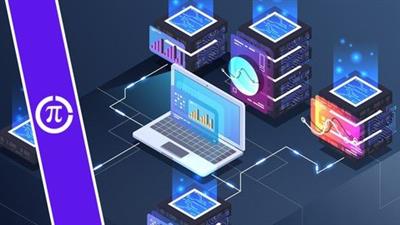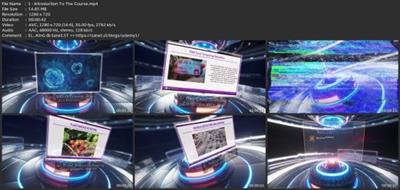
[center]Last updated 8/2021
MP4 | Video: h264, 1280x720 | Audio: AAC, 44.1 KHz
Language: English | Size: 1.21 GB | Duration: 2h 46m
Learn development & deployment of machine learning and deep learning application projects with python on heruko[/center]
What you'll learn
Build Deep Learning Models
Deployment Of Deep Learning Applications
Deep Learning Practical Applications
How to use DEEP NEURAL NETWORKS for image classification
How to use ARTIFICIAL NEURAL NETWORKS
Requirements
Knowledge Of Deep Learning
Knowledge Of Machine Learning
Description
Deployment of machine learning models means operationalizing your trained model to fulfill its intended business use case. If your model detects spam emails, operationalizing this model means integrating it into your company's email workflow-seamlessly. So, the next time you receive spam emails, it'll be automatically categorized as such. This step is also known as putting models into production.Machine learning models are deployed when they have been successful in the development stage-where the accuracy is considered acceptable on a dataset not used for development (also known as validation data). Also, the known faults of the model should be clearly documented before deployment.Even if your spam detection model has a 98% accuracy it doesn't mean it's perfect. There will always be some rough edges and that information needs to be clearly documented for future improvement. For example, emails with the words "save the date" in the subject line may always result in a spam prediction-even if it isn't. While this is not ideal, deployment with some of these known faults is not necessarily a deal breaker as long as you're able to improve its performance over time.Models can integrate into applications in several ways. One way is to have the model run as a separate cloud service. Applications that need to use the model can access it over a network. Another way is to have the model tightly integrated into the application itself. In this case, it will share a lot of the same computing resources.How the model integrates within your business systems requires careful planning. This should ideally happen before any development begins. The setup of the problem you are trying to solve and constraints under which models need to operate will dictate the best deployment strategy.For example, in detecting fraudulent credit card transactions, we need immediate confirmation on the legitimacy of a transaction. You can't have a model generate a prediction sometime today only to be available tomorrow. With such a time constraint, the model needs to be tightly integrated into the credit card processing application and be able to instantaneously deliver predictions. If over a network, it should incur very minimal network latency.For some applications, time is not of the essence. So we can wait for a certain amount of data to "pile up" before the machine learning model is run on that data. This is referred to as batch processing. For example, the recommendations you see from a shopping outlet may stay the same for a day or two. This is because the recommendations are only periodically "refreshed." Even if the machine learning models are sluggish, it doesn't have a big impact as long the recommendations are refreshed within the expected time range.
Overview
Section 1: Introduction
Lecture 1 Introduction To The Course
Lecture 2 Udemy Course Feedback
Section 2: Pan Card Tempering Detector
Lecture 3 Introduction To Pan Card Tempering Detector
Lecture 4 download скачать the code
Lecture 5 Loading libraries and dataset
Lecture 6 Creating the pancard detector with opencv
Lecture 7 Creating the Flask App
Lecture 8 Creating Important functions
Lecture 9 Deploy the app in Heruko
Lecture 10 Deploy the app in Heruko 2
Lecture 11 Testing the deployed pan card detector
Section 3: Project On Image Watermarking
Lecture 12 Introduction
Lecture 13 download скачать the code
Lecture 14 Importing libraries and logo
Lecture 15 Create text and image watermark
Lecture 16 Creating the app
Lecture 17 Deploying the app in heruko
Section 4: Project On Text Extraction From Images
Lecture 18 Introduction
Lecture 19 Importing libraries and data
Lecture 20 Extracting the test from image
Lecture 21 Modifiying the extractor
Lecture 22 creating the extractor app
Lecture 23 running the extractor app
Lecture 24 download скачать the code
Section 5: Project On Plant Disease Prediction
Lecture 25 Introduction
Lecture 26 Importing libraries and data
Lecture 27 Understanding the data and data preprocessing
Lecture 28 Model building
Lecture 29 Creating an app using streamlit
Lecture 30 download скачать the code
Section 6: Project On Counting & Detecting Vehicles
Lecture 31 Introduction
Lecture 32 Importing libraries and data
Lecture 33 Transforming Images and creating output
Lecture 34 Creating a flask APP
Lecture 35 download скачать the code
Beginners In Machine Learning

download скачать link
rapidgator.net:
https://rapidgator.net/file/ddb95f99e6a98817ee85981a1203ea7a/hgblo.Create..Deploy.Data.ScienceDeep.Learning.Web.Apps.2021.part1.rar.html https://rapidgator.net/file/35a12af1f30318a8624e4ceb1aadbf7f/hgblo.Create..Deploy.Data.ScienceDeep.Learning.Web.Apps.2021.part2.rar.html
uploadgig.com:
https://uploadgig.com/file/download скачать/c456E2832B967a24/hgblo.Create..Deploy.Data.ScienceDeep.Learning.Web.Apps.2021.part1.rar https://uploadgig.com/file/download скачать/fDA25Edd760803b8/hgblo.Create..Deploy.Data.ScienceDeep.Learning.Web.Apps.2021.part2.rar
nitroflare.com:
https://nitroflare.com/view/352F447DC5DF1A4/hgblo.Create..Deploy.Data.ScienceDeep.Learning.Web.Apps.2021.part1.rar https://nitroflare.com/view/44E4AB0A72765D7/hgblo.Create..Deploy.Data.ScienceDeep.Learning.Web.Apps.2021.part2.rar
1dl.net:
https://1dl.net/g0mrurdslqiq/hgblo.Create..Deploy.Data.ScienceDeep.Learning.Web.Apps.2021.part1.rar.html https://1dl.net/3v6nar373ut2/hgblo.Create..Deploy.Data.ScienceDeep.Learning.Web.Apps.2021.part2.rar.html

